KEEPING SALT OUT OF THE MURRAY SALT INTERCEPTION SCHEMES
KEEPING IN TOUCH DAYS AND SHARED PARENTAL35 KEEPING GOD’S DISTANCE SACRIFICE POSSESSION AND THE PROBLEM
4 GOALKEEPING 101 OR WHAT TO DO IF SOMEONE
4H RECORD KEEPING GUIDELINESCOMMENT SHEET RECORD KEEPING FORMS AND
50 TIPS FOR KEEPING A LEARNING LOG – REFLECTIONS
68 GLOSSARY OF UN PEACEKEEPING TERMS OVER THE
Keeping salt out of the Murray
Keeping salt out of the Murray
Salt Interception Schemes
Salt is a natural part of Murray-Darling Basin
landscapes and rivers. The groundwater systems close to the River
Murray hold more than 100,000 million tonnes of salt.
The salts
come from the weathering of rocks, from ancient oceans and from salts
deposited by rainfall (cyclic salt)
over millions of years. All
of this salt must necessarily find its way into the river before
reaching the sea; typically the river delivers around two million
tonnes of salt per year to the sea.
The Basin’s flat terrain, low rainfall and high evaporation rates contribute to increased salt concentration across the landscape. Land clearing and irrigation has increasingly mobilised salt (into the landscape and river systems). Compounding this has been the increasing proportion of river flows being diverted for irrigation, industrial and urban uses. There is now less flow in the river to dilute inflows of saline groundwater.
Methods to reduce and manage the amount of salt in the River Murray include:
reduce saline drainage by improved irrigation efficiency and better delivery systems;
re-use drainage waters on-farm irrigation;
river flow management – timed water releases to provide salinity dilution;
reduce the groundwater recharge and flow by planting deep rooted perennials;
zoning to direct new irrigation to areas of low salinity impact; and
divert saline groundwater before it enters the
River Murray through
salt interception and drainage
diversion schemes.
This brochure is about the Salt Interception and Drainage Diversion Schemes in the Murray-Darling Basin.
Salt
Interception Schemes –
What are they?
Salt interception schemes are large-scale pumping schemes that divert saline groundwater and drainage water before entering rivers. In most cases, a bore and pump system extracts the groundwater and pumps it to a salt management basin some distance from the river.
Since 1988 the States of New South Wales, Victoria and South Australia, together with the Australian Government, have funded the construction of salt interception schemes. These schemes prevent approximately half a million tonnes of salt per year from reaching the River Murray.
Salt interception schemes, together with other actions such as improved irrigation practices and river dilution flows, have reduced the salinity in the River Murray by approximately 200 EC* per year at Morgan in South Australia.
E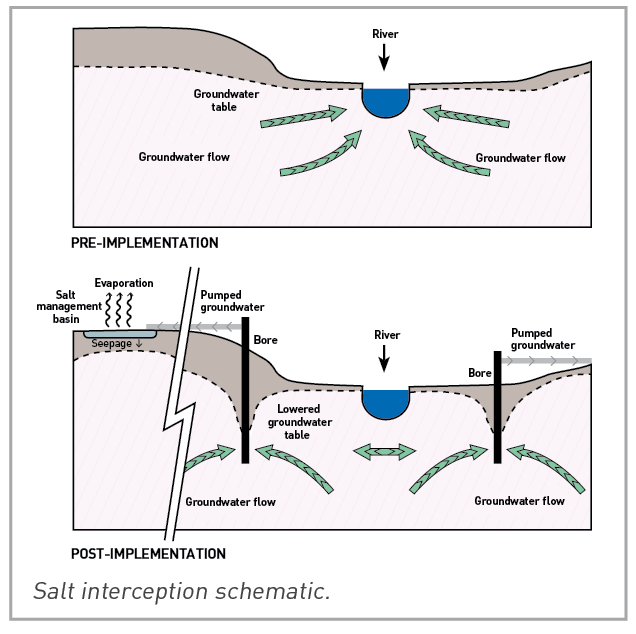 C
or Electrical Conductivity, a measure of salinity.
C
or Electrical Conductivity, a measure of salinity.
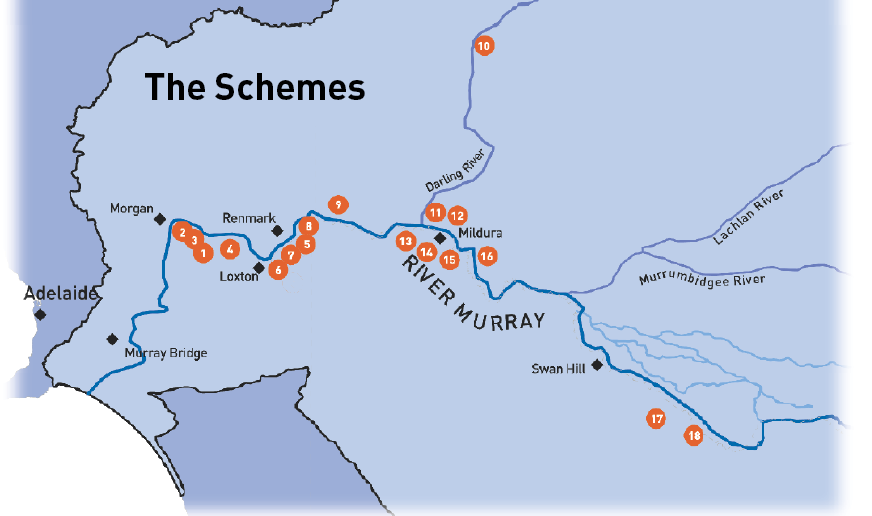
1, 2 Waikerie
Tonnes of salt per/day (max): 129
Year (commissioned): 1992 and 2010
Owner/Operator: SA on behalf of MDBA
Type
of Scheme: Groundwater pumping
to a
salt management
basin
3 Sunlands-Qualco
Tonnes of salt per/day (max): 19
Year (commissioned): 2001
Owner/Operator: SA
Type of Scheme: Groundwater and drainage pumping to a salt management basin
4 Woolpunda
Tonnes of salt per/day (max): 190
Year (commissioned): 1990/1992
Owner/Operator: SA on behalf of MDBA
Type
of Scheme: Groundwater pumping
to a
salt management
basin
5 PIKE
Tonnes of salt per/day (max): 14
Year (commissioned): 2011
Owner/Operator: SA
Type of Scheme: Groundwater pumping to a salt management basin
6 Loxton
Tonnes of salt per/day (max): 65
Year (commissioned): 2010.
Owner/Operator: SA on behalf of MDBA
Type
of Scheme: Groundwater pumping
to a
salt management
basin
7 Bookpurnong
Tonnes of salt per/day (max): 87
Year (commissioned): 2006
Owner/Operator: SA on behalf of MDBA
Type
of Scheme: Groundwater pumping
to a
salt management
basin
8 Murtho
Tonnes of salt per/day (max): 99
Year
(commissioned): Under construction
(expected to be completed in 2012).
Owner/Operator: SA on behalf of MDBA
Type
of Scheme: Groundwater pumping
to a
salt management
basin
9 Rufus River
Tonnes of salt per/day (max): 200
Year (commissioned): 1984
Owner/Operator: SA on behalf of MDBA
Type
of Scheme: Groundwater pumping
to a
salt management
basin
10 Upper Darling
Tonnes of salt per/day (max): 60
Year
(commissioned): Under construction
(expected to be completed in 2011).
Owner/Operator: NSW on behalf of MDBA
Type of Scheme: Groundwater pumping to salt management basins
11 Curlwaa
Tonnes of salt per/day (max): 9
Year (commissioned): 1973
Owner/Operator: NSW
Type
of Scheme: Groundwater pumping
to a
salt management
basin
12 Buronga
Tonnes of salt per/day (max): 200
Year (commissioned): 1979
(Upgrade: 1988 Rebuilt: 2005)
Owner/Operator: NSW on behalf of MDBA
Type of Scheme: Groundwater pumping to salt management basins
13 Mildura-Merbein
Tonnes of salt per/day (max): 140
Year (commissioned): 1981
(Upgrade: 1990)
Owner/Operator: VIC on behalf of MDBA
Type of Scheme: Groundwater pumping to salt management basins
14 Lake Hawthorn
Tonnes of salt per/day (max): 38
Year (commission ed): 1968
Owner/Operator: VIC
Type
of Scheme: Drainage pumping to
salt
management basins
15 Psyche Bend
Tonnes of salt per/day (max): 15
Year (commissioned): 1996
Owner/Operator: VIC
Type of Scheme: Drainage diversion
16 Mallee Cliffs
Tonnes of salt per/day (max): 100
Year (commissioned): 1994
Owner/Operator: NSW on behalf of MDBA
Type of Scheme: Groundwater pumping to salt management basins
17 Barr Creek
Tonnes of salt per/day (max): 85
Year (commissioned): 1968
Owner/Operator: VIC on behalf of MDBA
Type
of Scheme: Drainage diversion to
a
salt management basin
18 Pyramid Creek
Tonnes of salt per/day (max): 100
Year (commissioned): 2007
Owner/Operator: VIC on behalf of MDBA
Type of Scheme: Groundwater pumping to constructed salt harvesting basins
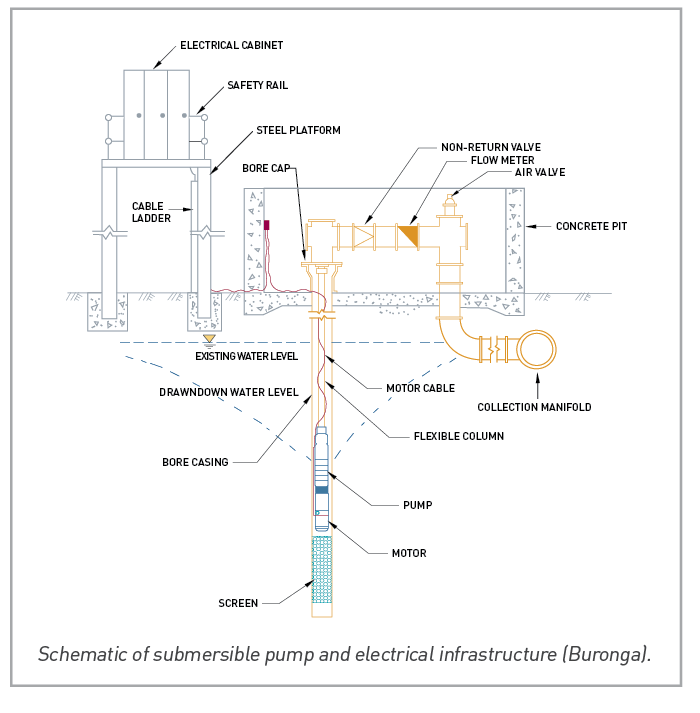
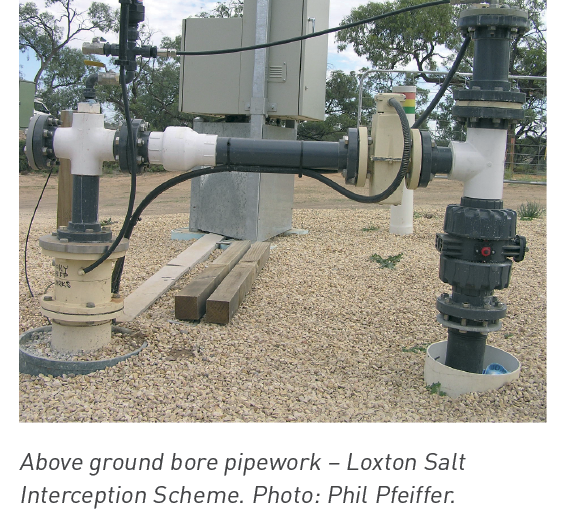
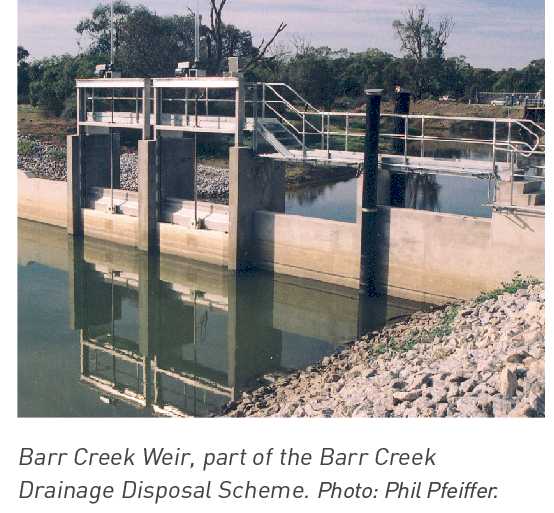
What
happens to the
collected salt?
The two basic methods of managing saline water from salt interception schemes are:
1. concentration and seepage back into the regional groundwater system
2. crystallisation/harvesting of salt.
Concentration and Seepage
Saline water is concentrated through solar evaporation and the resulting concentrated saline water seeps back very slowly into the already saline regional aquifer. The return of water to the groundwater system is only allowed where the time lag between disposal and return to river is very long, and benefit can be gained by deferring any immediate impacts.
Crystallisation/ Harvesting
In some salt management basins the water evaporates, leaving the crystallised salt on the surface. At a number of these basins, commercial operators harvest this salt. Different salts are extracted for different uses:
1. sodium chloride – used for table
salt, agriculture, swimming pools, the tanning industry and as a
de-icing agent;
2. calcium salts – used for gypsum (gypsum is primarily used in agriculture to improve soil structure);
3. bitterns – a mixture of magnesium, chloride, calcium and sodium left over from the above two extractions, used for dust suppression (for example, on dirt roads); and
4. magnesium sulphate extracted from the bitterns – used as a fertiliser, although much more expensive to extract than the other salts, it has a high value.
The Basin Salinity Management Strategy
In 2001, the Basin Salinity Management Strategy (2001–2015) (BSMS) replaced the Salinity and Drainage Strategy, the first coordinated salinity management initiative established in 1988.
The BSMS has an end-of-basin target of maintaining the River Murray salinity at Morgan below 800EC for 95% of the time and sets out how basin communities and governments will work together to control salinity and protect important assets and environmental values. A key element of the BSMS to achieve this target is through a joint works program to offset a predicted 61EC future increase in average salinity at Morgan.
Since these strategies came into effect, the partner governments of New South Wales, Victoria, South Australia and the Australian Government have, initially through the Murray-Darling Basin Commission and more recently the Murray-Darling Basin Authority, invested in the construction, operation and maintenance of Salt Interception and Drainage Disposal Schemes to meet the salinity targets of the BSMS, therefore protecting the River Murray from the impact of rising salinity.
Further Information
Murray-Darling Basin Authority
Telephone (02) 6279 0100
International + 61 2 6279 0100
Postal Address GPO Box 1801,
Canberra ACT 2601
For more information on Salinity
or Salt
Interception Schemes,
visit the Murray-Darling Basin Authority website:
www.mdba.gov.au
Front and back cover images:
Mallee
Cliffs Salt Management Basin.
Reprinted – September 2010
8 KEEPING THE FUTURE ALIVE PUTTING INCLUSIVE VALUES INTO
8 SECRETS TO KEEPING GOOD STAFF BY NEIL GUILMETTE
ARCHIVE FEBRUARY 2008 KEEPING THE FOCUS ON LEARNING ESPAÑOLSPANISH
Tags: interception schemes, salt interception, schemes, interception, murray, keeping
- DATUM SIDA 20051104 0 (1) KOMMUNALT FÖRLUSTANSVAR KFA FÖR
- GTBTW265REV1 PÁGINA 3 ORGANIZACIÓN MUNDIAL DEL COMERCIO GTBTW265REV1 23
- HAYS COUNTY COMMISSIONERS COURT MINUTES MARCH 9
- SOPOT 20181120 INFORMACJA Z OTWARCIA OFERT DOT PRZETARGU NIEOGRANICZONEGO
- MEDIMED 19TH EDITION THE EUROMEDITERRANEAN DOCUMENTARY MARKET SITGES
- 10H00 10H20 ACCUEIL – CAFÉ SALLE S001 AU
- WIPOGRTKFIC142 PAGE 2 OMPI F WIPOGRTKFIC142 ORIGINAL ANGLAIS
- NIEDOSKONAŁOŚCI NIEDOBROWOLNE MYŚLI PRAGNIENIA ODRUCHY WYPŁYWAJĄCE ZE SKAŻENIA
- ESTADO PLURINACIONAL DE BOLIVIA EMPRESA NACIONAL DE ELECTRICIDAD
- ACCUEIL PROGRAMME DÉTAILLÉ EN UN CLIN
- TOPOLYA KÖZSÉG JELENTKEZÉS KÖZMUNKA LEBONYOLÍTÁSÁRA – 2019 ÁLTALÁNOS ADATOK
- FICHA AUDICIÓN NOMBRE APELLIDOS REGISTRO DE VOZ FECHA
- INTRODUCCIÓN A LA EMPRESA PROGRAMA DE LA SEGUNDA
- BALLOON ROCKETS (DEMONSTRATING NEWTON’S THIRD LAW) NEWTON’S THIRD LAW
- SOCIAL MEDIA CONSUMER COMPLIANCE RISK MANAGEMENT GUIDANCE AGENCY FEDERAL
- 2 Open to Internal and External Candidates Vacancy Notice
- PLANUNG UNIT 5 ÜBERSICHT BEARBEITUNGSZEITRAUM 22 UNTERRICHTSSTUNDEN ABSCHNITT SBSEITEN
- CURRIC DEL DR ALFREDO GAONA SÁNCHEZ BEDUCACIÓN PROFESIONALB ULLIFACULTAD
- Financial Reporting for Schools Financial Services Division Published by
- 2007 NTHMP 5YEAR REVIEW FINDINGS THE NATIONAL TSUNAMI HAZARD
- A LA ASOCIACIÓN DE ENTIDADES DE CAZA DE LA
- NAČRT DELA OZVVS DOLENJSKA ZA LETO 2011 ZŠ AKTIVNOST
- 9 STAMPING WITH VAL ‘ENVELOPE PUNCH BOARD
- 8462 MACHINE TOOLS FOR FORGING BENDING STAMPING ETC 846210
- CURRICULUM VITAE PERSONAL INFORMATION GIRMAYE TESHOME HAILU ADDIS ABABA
- T HE WEST BENGAL UNIVERSITY OF HEALTH SCIENCES DD
- ACCUEIL EN SERVICE DE RÉANIMATION ACCUEIL EN RÉA
- NASTAVNI LISTIĆI 1 UVOD U LEKSIKOLOGIJU JEZIČNI ZNAK 2
- SLOVAK NATIONAL CENTRE FOR HUMAN RIGHTS INPUT OF THE
- HARTA NAGYKÖZSÉG ÖNKORMÁNYZAT KÉPVISELŐTESTÜLETÉNEK 92011(II18) ÖNKORMÁNYZATI RENDELETE A GYERMEKVÉDELMI
PROJECT NAME COMMUNICATIONS MANAGEMENT PLAN TEMPLATE VERSION 10 DRAFT
FORMATO PARA REALIZAR OBSERVACIONES INFORMES ESTUDIO TRANSMISIÓN TRONCAL 2010
ARRETE DE MISE A TEMPS PARTIEL DE DROIT POUR
 TIEMPOS DIFÍCILES CHARLES DICKENS CHARLES DICKENS TIEMPOS DIFÍCILES LIBRO
TIEMPOS DIFÍCILES CHARLES DICKENS CHARLES DICKENS TIEMPOS DIFÍCILES LIBRONzqa Unit Standard 27928 Version 2 Page 2 of
CARLETON UNIVERSITY JOINT HEALTH AND SAFETY COMMITTEE WORKPLACE
 DIRECCION DE VINCULACION TECNOLOGICA FORMULARIO PARA CALIFICACION DE PROYECTOS
DIRECCION DE VINCULACION TECNOLOGICA FORMULARIO PARA CALIFICACION DE PROYECTOSUSDA PAIN LEVELS USDA CATEGORY B USDA CATEGORY C
INTERPRETACIONES CHAMÁNICAS DE LAS NUEVAS TECNOLOGÍAS UN ESTUDIO
ANEJO 9 MODELO PARA LA APORTACION DE CORREO ELECTRÓNICO
UCHWAŁA NR 1 ZGROMADZENIA IZBY ADWOKACKIEJ W WARSZAWIE Z
 ESPACIO PARA EL LOGO ESCUDO Y/O ANAGRAMA DE LA OTRA ENTIDAD CONVENIO MARCO DE COLABORACIÓN
ESPACIO PARA EL LOGO ESCUDO Y/O ANAGRAMA DE LA OTRA ENTIDAD CONVENIO MARCO DE COLABORACIÓN ADJUSTMENTS FOR CHANGE IN PRIORYEAR ALLOCATION OF BUDGETARY RESOURCES
ADJUSTMENTS FOR CHANGE IN PRIORYEAR ALLOCATION OF BUDGETARY RESOURCESREGULAMIN KONKURSU NA NAJPIĘKNIEJSZY WIENIEC DOŻYNEK POWIATU BIALSKIEGO CELE
 SENATE RESOLUTION NO 99 STATE OF NEW JERSEY 214TH
SENATE RESOLUTION NO 99 STATE OF NEW JERSEY 214TH FORM 2 PARTICIPANT’S INFORMATION SHEET RESEARCH TITLE WORK
FORM 2 PARTICIPANT’S INFORMATION SHEET RESEARCH TITLE WORK NAME SUBJECT ADDRESS COUNCIL TAX REFERENCE NUMBER
NAME SUBJECT ADDRESS COUNCIL TAX REFERENCE NUMBER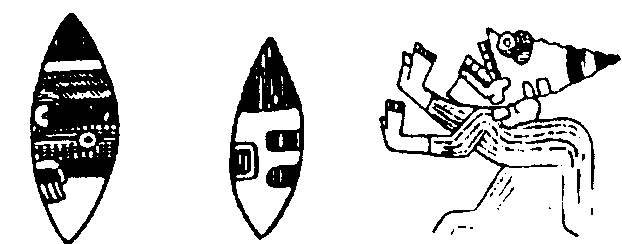 LA OBSIDIANA EN EL MUNDO SIMBÓLICO Y RITUAL
LA OBSIDIANA EN EL MUNDO SIMBÓLICO Y RITUAL ATF05 WP17 APPENDIX F TABLE CNS 1BBATN GROUND GROUND
ADVANCED LISTENINGSPEAKING THROUGH BROADWAY MUSICALS (VVI) 8WEEK PLAN THE